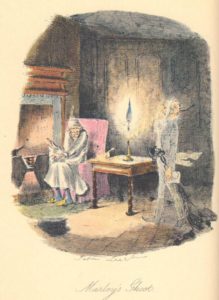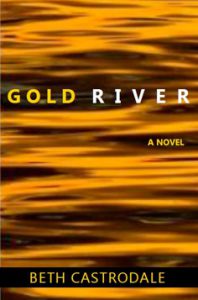We tend to associate ghost stories with Halloween. But in Victorian England, some of the spookiest tales were shared by the Yuletide fire.
Charles Dickens popularized the Christmas ghost story with his publication, in December 1843, of A Christmas Carol. But the tradition predated him by hundreds of years.

“Christmas as celebrated in Europe and the U.S. was originally connected to the ‘pagan’ Winter Solstice celebration and the festival known as Yule,” says Justin McDaniel, a professor of religious studies at the University of Pennsylvania. (McDaniel shared his observations with Omnia, a Penn Arts & Sciences publication.) “The darkest day of the year was seen by many as a time when the dead would have particularly good access to the living,” Accordingly, spirits figured into wintertime tales shared in Medieval Britain and Scandinavia, among other places.
After A Christmas Carol was published to great success, other spooky Yuletide tales followed on its heels, by such writers as Algernon Blackwood, A.M. Burrage, M.R. James, and Charlotte Riddell (who wrote under the pen name J.H. Riddell). Below, I’ll share a sampling of such tales, including two of a fairly recent vintage. Although not all the stories are set during Christmastime, they were intended to be shared then.
(As an aside, I recently found a publisher for a spooky story of my own, a novel featuring a housekeeper who may or may not be of this world. Stay tuned for more details.)
“A Strange Christmas Game,” by Charlotte Riddell (1863)
A brother and sister, John and Clare Lester, move into a country home once occupied by a distant relative, Jeremy Lester, who decades earlier, disappeared without a trace on Christmas Eve. Soon after moving into the home, John and Clare learn there may be a reason for the rumors that Jeremy “walks” the property: regularly, they hear footfalls and other disturbances at night.
One Christmas Eve, John stays up late, hoping to discover the source of the troubling sounds. He does. And eventually, he and Clare are led to a ghostly card game in the parlor, and to a scene that reveals the reason for Jeremy’s disappearance.
You can read the story here.
“Oh, Whistle, and I’ll Come to You, My Lad,” by M.R. James (1904)
While on holiday by the sea, a professor investigates some ancient ruins on the beach by his inn. There, he finds a whistle bearing two Latin inscriptions, one of which he translates as, “Who is this who is coming?” The other inscription remains troublingly mysterious. This doesn’t stop him from blowing the whistle, the equivalent of a horror-movie character hauling out a ouija board in a haunted house. Unsettling events ensue, including the appearance of a nightmare-inducing apparition in the professor’s room at the inn.
The BBC has produced two fine film versions of this story: a 1968 adaptation starring Michael Hordern and a 2010 adaptation starring John Hurt.
You can read the original story here.
“The Kit-Bag,” by Algernon Blackwood (1908)
Lacking luggage for his Christmas vacation to the Alps, a young man, Johnson, asks his boss to lend him a kit-bag. It happens that his boss is a barrister who just saw a notorious client, John Turk, acquitted of a gruesome murder, though “no man had ever better deserved the gallows.” Johnson, who witnessed the trial, is haunted by the sight of Turk’s face and by the description of how his victim’s dismembered body “was crammed and packed with lime into that …”
… kit bag.
That evening, Johnson takes delivery of just such a bag, but it isn’t the barrister’s. And it seems possessed by a malevolent, and potentially dangerous, spirit. The only other thing I’ll say of this story is that I can’t remember encountering more chilling descriptions of a supposedly inanimate object.
You can read the story here.
“Ofodile,” by Chimamanda Ngozi Adichie (2013)
In this chilling tale, a neighborly visit takes a dark turn.
It’s told from the point of view of a young girl, Chinelo, whose six-year-old brother, Ofodile, never speaks. Confined to his room, he only eats, sleeps, and lets out “piercing cries” that scare Chinelo and reverberate throughout the house.
One day, while his mother is feeding him, Ofodile sinks his teeth into her arm. Frightened and alarmed, she tranquilizes him with sleeping pills and makes sure his door is locked. This sets off a chain of disturbing events, beginning with a seemingly well-intentioned visit from two new neighbors: Dr. Igwe and his wife, Chidinma. Although Dr. Igwe is congenial, Chidinma barely speaks, and she seems to sense that Ofodile is locked away in his room. When she asks where he is on this occasion, and during a second visit, his mother says he’s asleep because he’s not feeling well.
After the second visit, the key to Ofodile’s door seems to have disappeared, and a sinister presence has taken over his room, a presence wearing the same scent as Chidinma. Chinelo must decide what to do, leading the story to a chilling conclusion, and raising questions about who–or what–Chidinma actually is.
You can read the story here.
“Stairs,” by Penelope Lively (2013)
Soon after a young woman, Laura, and her partner, Tim, move into a fixer-upper outside London, Laura gets a serious case of the creeps: first, from the cold spots that no new heating system can relieve; later, from an invisible presence that tries to shove her down the stairs.
Meanwhile, Tim becomes more and more cranky and withdrawn, spending more time on his home-improvement projects than with Laura.
As the months wear on, a nosy neighbor gives Laura troubling details about a couple who occupied the house years before. According to the neighbor, the wife had a “bad accident,” and “[t]here was talk [the husband] had something to do with it.”
This story’s echoes of The Shining gave me my own case of the creeps. You can read it here.
